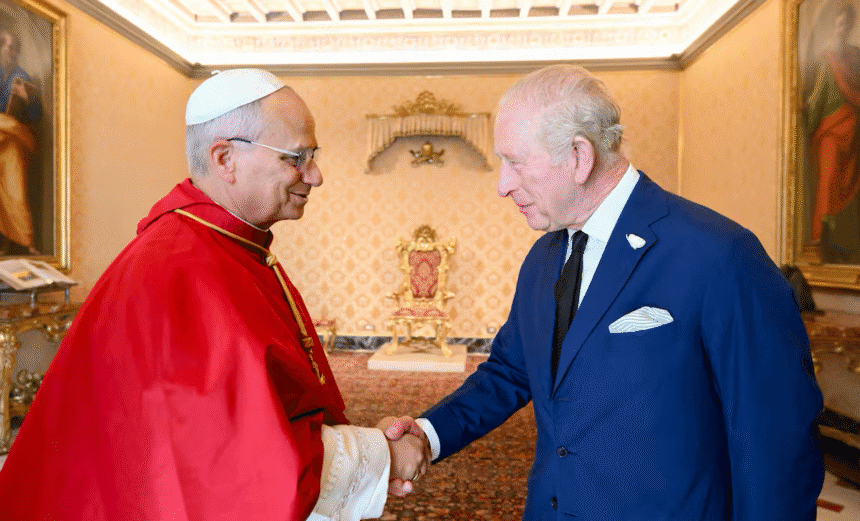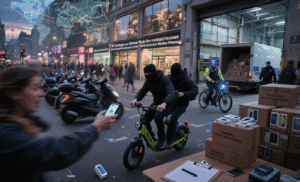In a moment steeped in symbolism and centuries of history, King Charles III became the first British monarch in 500 years to pray alongside the Pope. The historic event took place in the Sistine Chapel during the King’s state visit to the Holy See, where he joined Pope Leo XIV in a service of prayer beneath Michelangelo’s iconic frescoes. The unprecedented act of worship marks a powerful step toward reconciliation between the Church of England and the Roman Catholic Church, whose split dates back to the reign of King Henry VIII in the 16th century.
The visit, held on 22–23 October 2025, was part of King Charles’s continuing commitment to faith dialogue and environmental cooperation. During the two-day trip, he and Queen Camilla met with the Pope at the Apostolic Palace before attending an ecumenical service that brought together the Choir of the Chapel Royal and the Vatican’s Sistine Chapel Choir. The Archbishop of York, Stephen Cottrell, participated in the prayers, symbolizing unity between the two Christian traditions. The pair exchanged gifts, Charles presented the Pope with an icon of St Edward the Confessor, while the Pope offered the King a mosaic of Christ Pantocrator from Cefalù, Sicily, gestures that underscored mutual respect and shared spiritual heritage.
The joint prayer carries immense historical significance. The rift between England and Rome began in 1534 when Henry VIII severed ties with the Catholic Church, establishing the Church of England and declaring himself its Supreme Head. For centuries afterward, tensions and persecution defined the relationship between Anglicans and Catholics. Even after religious tolerance improved, formal unity remained distant. King Charles’s decision to pray publicly with Pope Leo is therefore seen as a defining gesture of goodwill, a culmination of decades of dialogue that began in earnest during the 20th century. Church leaders and scholars have hailed the moment as “a bridge across five centuries of division.”
Inside the Sistine Chapel, the atmosphere was reverent yet hopeful. The service combined Latin and English prayers, reflecting the shared Christian foundation of both churches. Themes of creation, peace, and stewardship of the Earth featured prominently, fitting for a King whose environmental advocacy has long shaped his public identity. Both leaders spoke briefly about the need for faith communities to unite in the face of global challenges such as climate change, poverty, and displacement. The joint liturgy concluded with the King receiving the honorary title of “Royal Confrater” at the Basilica of St. Paul Outside the Walls, while Pope Leo was granted a corresponding honorary title at Windsor Castle.
This historic moment resonates not only within the Christian world but across global politics and interfaith relations. Analysts note that the joint prayer reflects a broader movement toward religious cooperation in a time of polarization. For Pope Leo XIV, who has emphasized unity and compassion since his election, the meeting reaffirmed his vision of dialogue as the Church’s duty. For King Charles, whose reign has emphasized service, inclusion, and the moral responsibilities of leadership, the act demonstrated that monarchy can be a force for reconciliation rather than division. The sight of two faith leaders kneeling together beneath Michelangelo’s ceiling offered a vivid image of humility and shared purpose, a moment that transcended doctrine and politics alike.
The event also highlights how far the two churches have come since the 1960s, when official Anglican–Catholic dialogues first began. Over the years, multiple popes have met British monarchs, but none have prayed with them. Queen Elizabeth II met Popes John XXIII, John Paul II, and Francis, yet their encounters remained ceremonial. Charles’s choice to participate in prayer signifies not merely diplomacy, but deep personal conviction and a step toward genuine spiritual solidarity.
While the service did not erase theological differences or alter official church structures, it marked a profound acknowledgment of shared faith and moral mission. Both Buckingham Palace and the Vatican described the day as “a gesture of unity and peace.” Religious commentators have suggested that it could inspire future collaborations in areas such as climate action, humanitarian aid, and social justice. The joint prayer may also serve as a model for inter-Christian and interfaith understanding in a world increasingly divided by ideology.
For historians, 23 October 2025 will likely be remembered as a watershed, the day when, for the first time since the Reformation, a British monarch stood side by side with the Pope in prayer. What began as a simple act of worship became a living symbol of reconciliation, humility, and hope. After half a millennium of separation, two branches of Christianity found themselves once again united, if only for a moment, in shared faith beneath the painted heavens of the Sistine Chapel.

















